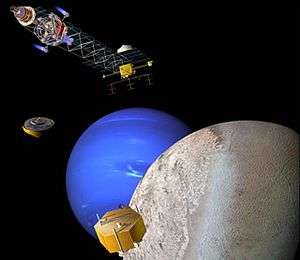Neptune Orbiter
Neptune Orbiter was a proposed NASA unmanned planetary spacecraft to explore the planet Neptune. It was envisioned that it would be launched sometime around 2016 and take 8 to 12 years to reach the planet; however, NASA's website no longer lists any possible launch date.[1] The Neptune Orbiter concept would have answered many questions about the nature of the planet.

Its objective was to study Neptune's atmosphere and weather, its ring system, and its moons, particularly Triton. The California Institute of Technology proposed one mission plan in 2004,[2] while the University of Idaho and Boeing proposed an alternative approach in 2005.[3]
Mission summary and status
Neptune Orbiter's primary mission was to go into orbit and perform scientific studies of the planet. The mission concept was first proposed to NASA in 2005. It was proposed to use a launch rocket similar to the Delta IV or Atlas V. The orbiter's trajectory was to use one Venus gravity assist, and a Jupiter gravity assist before arriving at Neptune. The length of time from launch until Neptune arrival was estimated to be 10.25 years.
Just prior to arriving, the orbiter would release its two atmospheric probes, which would transmit data before aerocapture. Then, it would begin Neptune orbit insertion by aerocapture. After adjusting its orbit to its planned science orbit, the orbiter would carry out studies of Neptune, its rings, atmosphere, weather, and its natural satellites. The main phase of the science operations would have taken from 3 to 5 years with a possible extension lasting 3 more years.
In 2008, the mission was removed from NASA's possible future missions list. According to NASA's 2010 budget, funding to missions to the outer Solar System was aimed at the future Europa Jupiter System Mission. The remaining budget was allocated to ongoing undertakings such as Cassini–Huygens, Juno, and New Horizons, with the Neptune system not being part of any official considerations.[4]
In 2011, NASA's Decadal Survey considered a mission to an ice giant—either Uranus or Neptune—but for feasibility reasons recommended a Uranus orbiter and probe.[5]
In 2019, a Neptune flyby proposal was made by the JPL under the name "Trident" for inclusion in the Discovery program.[6]
Power sources
Radioisotope thermoelectric generators
The Caltech mission concept would have been similar in design to previous NASA outer Solar System missions. It would use radioisotope thermoelectric generators for electrical power.[7] Based on this proposal, the spacecraft design would be similar to Galileo, Cassini–Huygens, Voyager 2, and New Horizons, with conventional thrusters for propulsion. Another proposal was to power the spacecraft with a nuclear-powered Stirling engine, which NASA were developing at that time and would be succeeded by the Kilopower study, together with ion propulsion.
Solar panels
Another proposal called for using solar panels to provide electrical power to the spacecraft. The panels would be inflatable, reducing their mass. Although advancements in solar panel technology means it should be possible to achieve sufficient power at the distance of Neptune, the high cost of providing the solar panels would possibly eliminate the idea of using solar cells. This design would presumably also use conventional thrusters, because the dim sunlight in the outer Solar System would probably be insufficient to power an ion propulsion system.
Instruments
Orbiter
The orbiter would have carried out the main mission objectives. Some proposed instruments were a multispectral imaging system to image the planet from ultraviolet to infrared, and a magnetometer, to investigate why the Neptune's magnetic field is oriented so far from the planet's axis of rotation.
Triton lander(s)
NASA scientists and engineers have considered to send one or two mini-landers to Triton's surface and analyze the composition of the surface, the interior, and the very rarefied nitrogen atmosphere. Various landing sites were suggested, among those the area with Nitrogen geysers that had been discovered by the Voyager spacecraft, but other locations were also proposed such as either the north or south poles of Triton. No final decision were however made since this were only a proposed mission. The landers' operational lifetime could have been anything between days to a month depending on power source and instrumentation.
Atmospheric probe(s)
Along with Triton landers, at least two atmospheric probes were proposed to descend through Neptune's atmosphere and study the climate and weather of the stormy planet. Similar to the Galileo probe that descended into Jupiter's atmosphere, the descent of a probe into the atmosphere of Neptune would take about 2–3 hours until the planet's atmospheric heat and pressure would destroy it – the data transmitted during the descent would allow a detailed analysis of Neptune's atmosphere.
References
- "Solar System Exploration: Missions: Solar System Strategic Exploration Plans". NASA. 2009-03-07. Archived from the original on 2009-08-05.
- Douglas Fiehler and Steven Oleson. (July 2004). "Neptune Orbiters Utilizing Solar and Radioisotope Electric Propulsion". American Institute of Aeronautics and Astronautics. Retrieved 3 September 2016.
- Bernie Bienstock and David Atkinson (10 June 2005). "NEPtune Orbiter with Probes" (PDF). Outer Planets Assessment Group. Retrieved 3 September 2016.
- "Planetary Science" (PDF). NASA. Retrieved 3 September 2016.
- "Vision and Voyages for Planetary Science in the Decade 2013–2022" (PDF). National Academies Press. Retrieved 3 September 2016.
- https://www.nytimes.com/2019/03/19/science/triton-neptune-nasa-trident.html
- Mohammed Omair Khan (September 15, 2009). "The Importance of Utilizing and Developing Radioisotope Electric Propulsion for Missions Beyond Saturn" (PDF). JPL/Caltech. Retrieved 3 September 2016.
_flatten_crop.jpg)